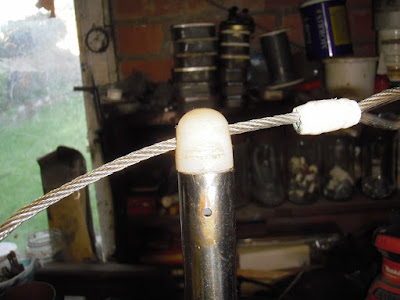When I first bought New Morning she came as a complete project with boxes of stuff, among them I found the guard wires and their stanchions. When I fitted them the forward most stanchion on the port side had been repaired at some time in the past, the top guard wire passed through the plastic plugs fitted to the top of the the stanchions however on the forward stanchion the plastic plug had been sheared off and had been replaced with a piece of stainless steel bent round to retain the guard wire and pop riveted to the stanchion.
The New Morning Project
Thursday, 19 January 2023
A bit of a conundrum
Friday, 12 August 2022
Shore supply
I have recently started a new project which is to install a shore power supply this will be useful for a number of reasons, the main one is to keep the batteries fully charged in the winter especially when using the heater which I have not got round to yet. I started by installing the connection for the incoming supply in the forward cockpit bulkhead, I used a previous opening which housed the defunct Stowe echo sounder, wherever possible I try to to reuse openings I have an aversion to cutting unnecessary holes in the boat.
Friday, 6 May 2022
New mainsail
The existing mainsail suffered some damage during storm Eunice this year, my fault as I had not taken the sails off for the winter as I normally do, I had removed the spray hood. The damage was not serious some stitching had come undone on the leech but as the sail was old possibly as old as the boat I decided to replace it, two years ago the local sailmaker said it was on its last legs something like if you get another season out of it you will be lucky. I did a temporary repair to the old sail with some sail repair tape and ordered a new sail from Crusader Sails also a stack pack. The aim was to convert to slab reefing from the old roller reefing so I also ordered a new Barton 32mm slab reefing kit
Friday, 25 February 2022
Further thoughts on the heater
I have been looking into possibly installing the diesel heater in the steering gear space utilising CAD, that is cardboard aided design. I mocked up a bracket with the idea of glassing it to the inside of the transom. this will give a vertical surface to take the heater mounting bracket.
Friday, 28 January 2022
Door frames finished this week
I finally wrapped up the door frames this week by completing the aft door. After completing the forward door frame I made up the final piece of the liner for the opening I had to glue two pieces together to get the right size it was then glued and screwed into place and then I cut two pieces of laminate for the infill on each side of the door. I already had the rest of the parts of the door frame made up so it was just a matter of securing them and plugging the screw holes, sanding all over and then applying two coats of Colron deep mahogany wood dye. Once the dye had fully dried it was just a matter of applying three coats of varnish and the job is done.
Thursday, 30 December 2021
Door frames
New Morning has not been totally neglected since my last post I have been pottering about doing odd maintenance jobs but recently I became motivated to finish off the heads door frames. Since this involved making up four arch section pieces of architrave to suit the original doors I had been putting off starting the job, however I decided that it was time to get on and get them finished. I started by making the four arch sections these are made from six pieces dowelled and glued together before being cut to shape with a jig saw and sanding.
Friday, 8 October 2021
About time I wrote something
Over the past few months I have not done an awful lot on New Morning mostly cleaning and maintenance work the usual general stuff not really a lot to write about. However I have done a couple of bits and pieces which I will include in one post.
I managed some sailing this year with a couple of trips across the Thames estuary, the first in July to the Colne and the Blackwater and in September to the Roach and then up the Crouch to Fambridge otherwise it has been a case of pottering in the Swale. The first job I carried out was as a result of the trip to the Colne, and after spending the night at anchor and then raising and stowing the said anchor I decided that the 35lb CQR anchor was going, I had already thought seriously about it on previous trips it was extremely awkward too deploy and recover especially through the gap between the forestay and the pulpit so after this trip I decided that it had definitely got to go, After some research looking at selection charts I decided that a 22lb Delta would be adequate which was duly obtained from Cactus Marine who had a special offer on them.







































